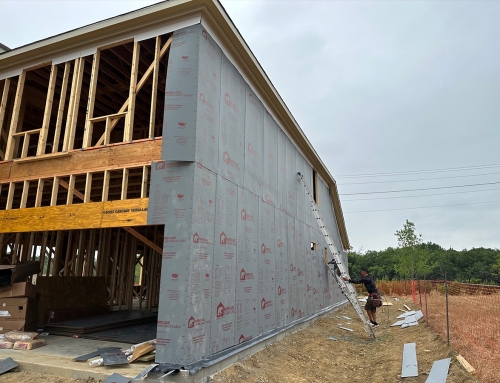New construction projects can avoid air barrier system failures by hiring qualified professionals, utilizing the whole-building airtightness approach, and choosing high quality and manufacturer recommended products. Experienced professionals will ensure proper installation by following manufacturer guidelines and paying attention to small details that prevent gaps and cracks that lead to air barrier system failure.
A superior product for creating an airtight building envelope is Barricade® Building Wrap. Barricade Wrap, when properly installed, provides exceptional strength which reduces the chances of damage before, during and after application. Thereby, Barricade Building Wrap creates a continuous, whole-building airtightness that ensures the long-term integrity and performance of a building.
Vapor Permeable Air Barriers Control Air Infiltration and Moisture Accumulation within the Wall System

The goal of a vapor-permeable air barrier is to create a tight building envelope that controls airflow between conditioned (heated or cooled) and unconditioned spaces. However, the air barrier must also allow moisture within the wall system to escape.
Moisture may accumulate in the wall system when warm air (that contains water molecules) moves towards cooler air in the wall system by the process of thermal convection. When the water vapor reaches the cool surfaces in the wall system, condensation occurs, forming water droplets. Therefore, it is important that the air barrier be vapor-permeable, so that water within the wall system can evaporate.
A quality air barrier creates an energy-efficient and moisture-resistant building by minimizing air infiltration and moisture accumulation within the wall system.
The Consequences of a Failed Air Barrier System
An effective air barrier reduces energy costs and keeps water (liquid or vapor) out of the wall assembly. However, if an air barrier fails, a building becomes less energy-efficient, durable and healthy for the occupants.
- Air barrier failures cause air leakages in and out of a building. Air leaks lower the building’s R-value, which ultimately cost building owners more in energy bills. Furthermore, the HVAC system has to work harder to compensate, which reduces its service life.
- If an air barrier fails, water can become trapped in the wall system. Moisture accumulation in the wall system can lead to mold and rot. Mold is unhealthy for the occupants of the structure. Rot reduces the integrity of the building.
Six Ways an Air Barrier System can Fail

Incorrect or careless installation of a building’s air barrier can diminish the airtightness of the building’s envelope, the long-term structural integrity (durability) of the structure, and the comfort and health for the occupants. There are several reasons an air barrier may fail, mainly due to application error or the use of substandard products.
-
Effective Air Barriers Integrate with the Whole Building
The whole-building airtightness approach is key to avoiding air barrier failures. The whole-building airtightness approach integrates the air barrier with the windows, doors, curtain walls, roofing, and flooring systems. Notably, the whole-building air barrier is only as strong as its weakest component.
-
Successful Air barriers Are Continuous and Next to the Insulation Layer
Air barriers will fail if not continuous and next to the insulation layer. It is particularly critical when installing an air barrier that continuities at the junctures (e.g., wall to wall, floor to wall, and wall to roof) and penetrations are intact. The smallest discontinuity in the air barrier can cause significant air leakage and greatly lessen the effectiveness of the air barrier system.
-
Successful Air Barriers Use Compatible Parts
It is essential to the success of an air barrier to use compatible and manufacturer recommended products. Air barrier failures will occur if the materials used are not compatible.
-
Successful Air Barriers Are Durable
Air barrier failures may occur if the materials used are not strong and durable. It is key to the long-term performance of an air barrier that it has the strength and durability to minimize damage from outside events (rain, sun, wind) or rough handling during the installation process.
-
Effective Air Barriers are Flexible
Air barriers can fail if they don’t have the juncture flexibility to adjust when a building settles, sways, expands, or contracts. Without juncture flexibility, a structure may leak like a sieve as it ages. An air barrier that allows movement in membrane connections and uses tape that can stretch will lessen the chance of an air barrier failure.
-
A Blower Door Test is Key to a Successful Air Barrier
A blower door test is vital to ensuring an air barrier’s airtightness and continuity. A blower door is a diagnostic tool that identifies leaks and allows for timely repairs to the air barrier. The 2015 IECC also requires air leakage testing of a building envelope in accordance with either ASTM E 779 or ASTM E 1827. Qualified professionals will always conduct a blower door test to ensure an air barrier will not fail.
Avoid Air Barrier System Failures with Barricade Building Wrap

Barricade® Building Wrap is air- and water-resistant building barrier that avoids many of the failures common for air barrier systems. Barricade Building Wrap has excellent strength and durability, which will lessen damage from outside elements or rough handling during the installation process.
Importantly, Barricade Building Wrap provides drainage, UV inhibitors, tear strength, temperature resistance, and vapor permeability. An excellent product for preventing air barrier failure and ensuring the long-term durability and performance of a building is Barricade Building Wrap.







